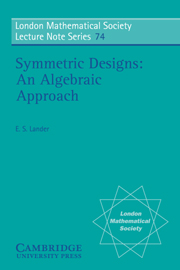CHAPTER 1 - SYMMETRIC DESIGNS
Published online by Cambridge University Press: 16 March 2010
Summary
Definitions And Simple Examples
An incidence structure consists simply of a set P of points and a set g of blocks, with a relation of incidence between points and blocks. Being of such a general nature, incidence structures arise naturally in all branches of mathematics. The particular sort which is the subject of this monograph– –symmetric designs– –arose first in the statistical theory of the design of experiments, but they rapidly have become objects of great combinatorial interest in their own right.
A symmetric (v, k, λ) design (or a symmetric design with parameters (v, k, λ))is an incidence structure satisfying the following six requirements:
There are v points.
There are v blocks.
Any block is incident with k points.
Any point is incident with k blocks.
Any two blocks are incident with λ points.
Any two points are incident with λ blocks.
To exclude degenerate cases, we also insist that k > λ.
These axioms are not independent, and we shall explore them further in §1.4.
Example 1. The paradigmatic example of a symmetric design is represented in Figure 1.1. This symmetric design has parameters (7, 3, 1). The seven points are 1, 2, 3, 4, 5, 6, and 7. The seven blocks are the sets {1, 2, 4}, {2, 3, 5}, {3, 4, 6}, {4, 5, 7}, {5, 6, 1}, {6, 7, 2} and {7, 1, 3}. A point p is incident with a block B if p ε B.
- Type
- Chapter
- Information
- Symmetric DesignsAn Algebraic Approach, pp. 1 - 41Publisher: Cambridge University PressPrint publication year: 1983



